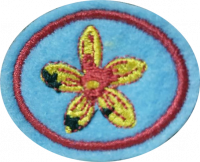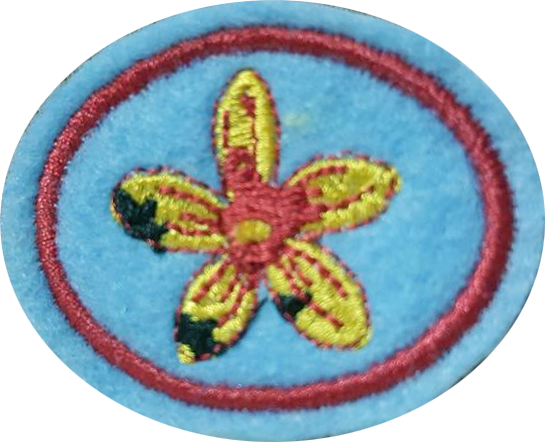Difference between revisions of "AY Honors/Fabric Yo-Yo/Answer Key"
(+ SAD Fabric Yo-Yo honor requirements) |
m (- Category of AYHAB) |
||
| (8 intermediate revisions by 3 users not shown) | |||
| Line 1: | Line 1: | ||
| − | + | {{HonorSubpage}} | |
| − | < | + | <section begin="Body" /> |
| − | {{ | + | {{ansreq|page={{#titleparts:{{PAGENAME}}|2|1}}|num=1}} |
| − | | | + | <noinclude><translate><!--T:23--> |
| − | | | + | </noinclude> |
| − | | | + | <!-- 1. Define what fabric yo-yo is. What is the origin of this technique? --> |
| − | | | ||
| − | |||
| − | |||
| − | |||
| − | |||
| − | |||
| − | |||
| + | <!--T:3--> | ||
Fabric yo-yo consists of taking advantage of and recycling the scraps of colorful fabrics used by stylists and seamstresses to create beautiful pieces. The word "fuxico" in Portuguese means "gossip" and this technique comes from when women were supposed to meet and go into "conversations and gossip", and would make these small pieces in the meantime. From cutting, folding and uniting, suddenly these beautiful flowers appeared that could adorn a lapel, a wallet, cushions, hair clips, and many other applications. Most of these works of art consist of small circles of fabrics that are stitched, sewn, and glued together to decorate a surface. Buttons, ribbons, beads, bows and pearls are added as final details. | Fabric yo-yo consists of taking advantage of and recycling the scraps of colorful fabrics used by stylists and seamstresses to create beautiful pieces. The word "fuxico" in Portuguese means "gossip" and this technique comes from when women were supposed to meet and go into "conversations and gossip", and would make these small pieces in the meantime. From cutting, folding and uniting, suddenly these beautiful flowers appeared that could adorn a lapel, a wallet, cushions, hair clips, and many other applications. Most of these works of art consist of small circles of fabrics that are stitched, sewn, and glued together to decorate a surface. Buttons, ribbons, beads, bows and pearls are added as final details. | ||
| + | <!--T:4--> | ||
In English it is known as "fabric yo-yo" and in the 1930s they were very popular and are still used today. They make great accessories for hair, dolls, small animals, etc. which are formed by many rounds of cloth or fabric. | In English it is known as "fabric yo-yo" and in the 1930s they were very popular and are still used today. They make great accessories for hair, dolls, small animals, etc. which are formed by many rounds of cloth or fabric. | ||
| − | ==2. What is the main goal of this technique? | + | <!--T:24--> |
| + | <noinclude></translate></noinclude> | ||
| + | {{CloseReq}} <!-- 1 --> | ||
| + | {{ansreq|page={{#titleparts:{{PAGENAME}}|2|1}}|num=2}} | ||
| + | <noinclude><translate><!--T:25--> | ||
| + | </noinclude> | ||
| + | <!-- 2. What is the main goal of this technique? --> | ||
| − | ==3. Explain the stages of this technique. | + | <!--T:26--> |
| + | <noinclude></translate></noinclude> | ||
| + | {{CloseReq}} <!-- 2 --> | ||
| + | {{ansreq|page={{#titleparts:{{PAGENAME}}|2|1}}|num=3}} | ||
| + | <noinclude><translate><!--T:27--> | ||
| + | </noinclude> | ||
| + | <!-- 3. Explain the stages of this technique. --> | ||
| − | ==4. What materials and tools are necessary? | + | <!--T:28--> |
| + | <noinclude></translate></noinclude> | ||
| + | {{CloseReq}} <!-- 3 --> | ||
| + | {{ansreq|page={{#titleparts:{{PAGENAME}}|2|1}}|num=4}} | ||
| + | <noinclude><translate><!--T:29--> | ||
| + | </noinclude> | ||
| + | <!-- 4. What materials and tools are necessary? --> | ||
| − | ==5. Demonstrate and give examples of the following: | + | <!--T:30--> |
| + | <noinclude></translate></noinclude> | ||
| + | {{CloseReq}} <!-- 4 --> | ||
| + | {{ansreq|page={{#titleparts:{{PAGENAME}}|2|1}}|num=5}} | ||
| + | <noinclude><translate><!--T:31--> | ||
| + | </noinclude> | ||
| + | <!-- 5. Demonstrate and give examples of the following: --> | ||
| − | == | + | <!--T:32--> |
| + | <noinclude></translate></noinclude> | ||
| + | {{ansreq|page={{#titleparts:{{PAGENAME}}|2|1}}|num=5a}} <!--T:9--> | ||
| + | <noinclude><translate><!--T:33--> | ||
| + | </noinclude> | ||
| − | == | + | <!--T:34--> |
| + | <noinclude></translate></noinclude> | ||
| + | {{CloseReq}} <!-- 5a --> | ||
| + | {{ansreq|page={{#titleparts:{{PAGENAME}}|2|1}}|num=5b}} <!--T:10--> | ||
| + | <noinclude><translate><!--T:35--> | ||
| + | </noinclude> | ||
| − | == | + | <!--T:36--> |
| + | <noinclude></translate></noinclude> | ||
| + | {{CloseReq}} <!-- 5b --> | ||
| + | {{ansreq|page={{#titleparts:{{PAGENAME}}|2|1}}|num=5c}} <!--T:11--> | ||
| + | <noinclude><translate><!--T:37--> | ||
| + | </noinclude> | ||
| − | ==6. Choose two of the following activities and put into practice what mentioned in requirement 5: | + | <!--T:38--> |
| + | <noinclude></translate></noinclude> | ||
| + | {{CloseReq}} <!-- 5c --> | ||
| + | {{CloseReq}} <!-- 5 --> | ||
| + | {{ansreq|page={{#titleparts:{{PAGENAME}}|2|1}}|num=6}} | ||
| + | <noinclude><translate><!--T:39--> | ||
| + | </noinclude> | ||
| + | <!-- 6. Choose two of the following activities and put into practice what mentioned in requirement 5: --> | ||
| − | == | + | <!--T:40--> |
| + | <noinclude></translate></noinclude> | ||
| + | {{ansreq|page={{#titleparts:{{PAGENAME}}|2|1}}|num=6a}} <!--T:13--> | ||
| + | <noinclude><translate><!--T:41--> | ||
| + | </noinclude> | ||
| − | == | + | <!--T:42--> |
| + | <noinclude></translate></noinclude> | ||
| + | {{CloseReq}} <!-- 6a --> | ||
| + | {{ansreq|page={{#titleparts:{{PAGENAME}}|2|1}}|num=6b}} <!--T:14--> | ||
| + | <noinclude><translate><!--T:43--> | ||
| + | </noinclude> | ||
| − | == | + | <!--T:44--> |
| + | <noinclude></translate></noinclude> | ||
| + | {{CloseReq}} <!-- 6b --> | ||
| + | {{ansreq|page={{#titleparts:{{PAGENAME}}|2|1}}|num=6c}} <!--T:15--> | ||
| + | <noinclude><translate><!--T:45--> | ||
| + | </noinclude> | ||
| − | == | + | <!--T:46--> |
| + | <noinclude></translate></noinclude> | ||
| + | {{CloseReq}} <!-- 6c --> | ||
| + | {{ansreq|page={{#titleparts:{{PAGENAME}}|2|1}}|num=6d}} <!--T:16--> | ||
| + | <noinclude><translate><!--T:47--> | ||
| + | </noinclude> | ||
| − | == | + | <!--T:48--> |
| + | <noinclude></translate></noinclude> | ||
| + | {{CloseReq}} <!-- 6d --> | ||
| + | {{ansreq|page={{#titleparts:{{PAGENAME}}|2|1}}|num=6e}} <!--T:17--> | ||
| + | <noinclude><translate><!--T:49--> | ||
| + | </noinclude> | ||
| − | == | + | <!--T:50--> |
| + | <noinclude></translate></noinclude> | ||
| + | {{CloseReq}} <!-- 6e --> | ||
| + | {{ansreq|page={{#titleparts:{{PAGENAME}}|2|1}}|num=6f}} <!--T:18--> | ||
| + | <noinclude><translate><!--T:51--> | ||
| + | </noinclude> | ||
| − | == | + | <!--T:52--> |
| + | <noinclude></translate></noinclude> | ||
| + | {{CloseReq}} <!-- 6f --> | ||
| + | {{ansreq|page={{#titleparts:{{PAGENAME}}|2|1}}|num=6g}} <!--T:19--> | ||
| + | <noinclude><translate><!--T:53--> | ||
| + | </noinclude> | ||
| − | ==References== | + | <!--T:54--> |
| + | <noinclude></translate></noinclude> | ||
| + | {{CloseReq}} <!-- 6g --> | ||
| + | {{CloseReq}} <!-- 6 --> | ||
| + | <noinclude><translate></noinclude> | ||
| + | ==References== <!--T:20--> | ||
| + | <!--T:21--> | ||
[http://estelaartesanias.blogspot.com/search?q=fuxico Blog about different weaving art] | [http://estelaartesanias.blogspot.com/search?q=fuxico Blog about different weaving art] | ||
| − | |||
<noinclude></translate></noinclude> | <noinclude></translate></noinclude> | ||
| + | {{CloseHonorPage}} | ||
Latest revision as of 16:23, 14 July 2022
1
Fabric yo-yo consists of taking advantage of and recycling the scraps of colorful fabrics used by stylists and seamstresses to create beautiful pieces. The word "fuxico" in Portuguese means "gossip" and this technique comes from when women were supposed to meet and go into "conversations and gossip", and would make these small pieces in the meantime. From cutting, folding and uniting, suddenly these beautiful flowers appeared that could adorn a lapel, a wallet, cushions, hair clips, and many other applications. Most of these works of art consist of small circles of fabrics that are stitched, sewn, and glued together to decorate a surface. Buttons, ribbons, beads, bows and pearls are added as final details.
In English it is known as "fabric yo-yo" and in the 1930s they were very popular and are still used today. They make great accessories for hair, dolls, small animals, etc. which are formed by many rounds of cloth or fabric.
2
3
4
5
5a
5b
5c
6
6a
6b
6c
6d
6e
6f
6g



